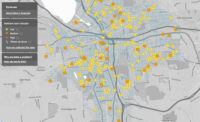To most consumers, advanced meters are the poster child for smart- grid efforts. Workers are installing millions of these digital meters around the United States to improve two-way communication between customers and their electric utilities.

But for transmission and distribution companies, “smart grid” means something else: the addition of “intelligent infrastructure” layers over standard poles and wires. And for these companies, “smart grid” means big business.
“We expect $50 billion worth of transmission and distribution lines over the course of the next five to seven years, and they will be built in a new and different fashion,” says Marc Gabriel, senior vice president and executive director of strategy practice for Overland Park, Kan.-based Black & Veatch. Gabriel says the days of standard transmission and distribution construction are gone; new lines and substations will contain all the elements of a smart grid. “A marriage between traditional construction and construction of intelligent infrastructure has to [happen],” Gabriel says. “Certainly, traditional transmission and distribution companies are going to have to upscale their game.”
The Price of Expertise
Although some lawmakers are pushing back against the expense of the advanced meters and raising red flags about smart- grid security, Gabriel doesn't see these concerns slowing the spread of advanced meters or other smart-grid infrastructure necessary to upgrade electrical systems.
According to an April report by Palo Alto, Calif.-based Electric Power Research Institute, the estimated cost to deploy a fully functional smart grid across the U.S. is between $338 billion and $476 billion. A majority of that total would be spent on advanced sensors, measurement units and monitors on transmission and distribution lines in electric substations and powerplants.
For the most part, traditional line and pole developers are relying on third-party expertise to implement elements of smart grids. Increasingly, those companies are adding in-house expertise. For example, Houston-based Quanta Services, one of the largest T&D builders in the country, has added more than 100 employees to focus on intelligent infrastructure.
On May 16, McLean, Va.-based Science Applications International said it acquired the transmission and distribution engineering capabilities of Lisle, Ill.-based Patrick Energy Services to boost prospects for its smart-grid portfolio. The acquisition follows SAIC's purchase of R.W. Beck and the Benham Cos. “None of these companies were for sale, but we approached them with our strategy and told them that this approach is something that is really going to sustain the business,” says J.T. Grumski, senior vice president of SAIC.
Turning Points
Gabriel says the industry is at a critical point: An overlay of intelligent infrastructure is needed because fewer powerplants are being built, and utilities have to do more with less. With smart-grid technology, utilities can remotely monitor power plant operations or pinpoint problematic power lines.
The pieces themselves, however, aren't nearly as powerful as the whole. “You're building up the physical infrastructure, and you're building up the IT infrastructure and the communication infrastructure to propel the end game—which is a true smart grid,” says Jim Baxter, formerly of R.W. Beck. “The end game means better demand response and better energy efficiency, and the whole concept of integrated renewable [systems] and ultimately the concept of self-healing systems.”

